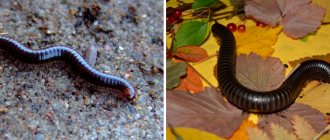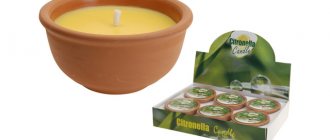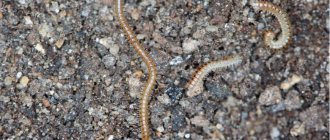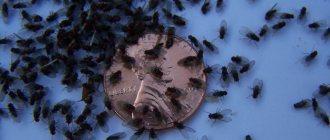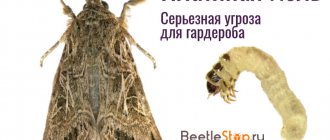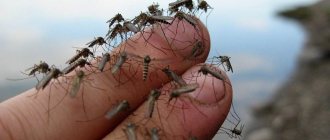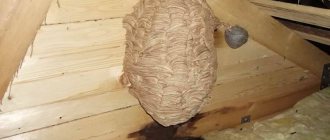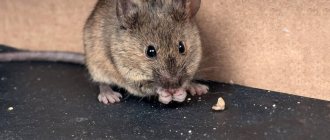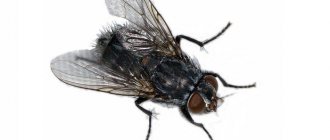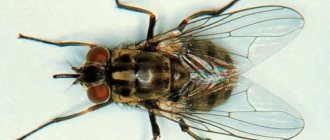If you thought that a fly was just one type of annoying insect, you should be disappointed. In Russia alone there are more than 400 species, and many of the synanthropic species (ecologically closely related to humans and their homes) pose a great danger to human health.
Today we are not talking about garden pests (onion, carrot, cabbage, iris and other flies), but rather about those dipterous insects that most often catch the eye of a person, and even actively attack him. So, who is here annoyingly curling and buzzing?
Housefly
The most common synanthropic species around the world is the housefly.
This yellow-gray insect is about 8 mm long with large faceted bright red eyes, a downward proboscis with “pads” at the end, large transparent wings and long black legs with suction cups.
How long do house flies live? A week or two or three - it all depends on the ambient temperature. The optimal temperature for insects is about 23°C. During her life, a female is capable of laying several clutches, up to 100 eggs in each, and she is capable of reproducing all year round - up to 20 generations of flies can change in a year in a warm apartment.
House flies do not bite humans; their mouthparts are not adapted for this. These are polyphags - they eat almost anything that their saliva can dissolve, or possibly scrape off with the help of the lobes of the oral apparatus. And a well-developed sense of smell helps the fly search for food.
Houseflies are harmful to humans, primarily by spoiling food, as well as by transmitting worm eggs and pathogens of many bacterial and viral infections (intestinal, eye, respiratory, etc.). Plus, insects in the apartment simply buzz annoyingly, and sit on a person’s skin and mucous membranes, trying to lick off sweat, blood from abrasions and other liquids.
How to get rid of flies in the house? They can develop in almost any decomposing substances of plant and animal origin, therefore, first of all, it is important to maintain cleanliness in the premises, timely removal of kitchen waste and garbage, and closed containers for its storage. To limit the entry of flies into the house, protective nets are used on windows and doors. Extermination measures consist of setting traps (sticky tapes, poisoned baits), mechanical extermination of insects, as well as the use of insecticides (especially in places where larvae develop), repellents and fumigators.
- House flies - why they are dangerous to humans and how to get rid of them
We offer proven means of controlling flies. We also tell you how to make a cool trap from an ordinary bottle!
house fly
Although this fly is often confused with the one described above, they are different species, they even belong to different genera.
They are really similar in appearance, but unlike the housefly, the housefly is larger and darker, and its legs are dark yellow.
It causes as much harm as the indoor one, plus its larvae can parasitize warm-blooded animals, including humans, causing skin and abdominal inflammation-myiases.
Measures to combat house flies are similar to those used against house flies.
- Annoying and especially dangerous: 7 folk remedies for flies
Let's get acquainted with time-tested folk remedies for flies.
Ilnitsa-beeweed (tenacious Ilnitsa)
This type of fly belongs to the hoverfly family. In appearance they are similar to an ordinary bee. The average length is 1.5 cm. The abdomen is dark brown in color, covered with plumage of small hairs; on the side there are large red spots with a yellowish tint. In the middle part of the fly's face there is a wide, well-developed shiny black stripe. Before our eyes - two
vertical stripes with thick hair. The hind limbs in the lower leg area are also covered with hairs. The insect's thighs are almost black.
The larva of the bee moth is dark with a gray tint. The body of the larvae has a cylindrical shape and reaches a length of 10–20 mm. The larva breathes using a special breathing tube, which can stretch up to 100 mm in length. This organ is very important for her, since she lives in conditions of fetid liquids, garbage pits and pond sewage, and can only breathe clean air.
This insect is active from July to October. Illices feed on the nectar of various flowering plants.
Beeworm larvae can be the source of a dangerous intestinal disease found in some European countries, Africa, Australia, Chile, Argentina, India, Iran and Brazil.
The disease occurs as a result of fly eggs entering the human intestines along with food. There the larva hatches and begins to develop, causing enteritis.
Autumn fly
This synanthropic fly is very similar in appearance to the house fly, but unlike it, it is “shorter” and more compact, and most importantly, it does not have a licking-sucking mouthpart, but a piercing-sucking one (its proboscis is straight and sticks out forward, not down). This means that the zhigalka “bites” - sitting on the skin, it instantly drills through it, injecting saliva into the wound (it is because of this that the bite is so painful) and sucking out the blood. Both females and males bite.
Light flies attack quietly and unnoticed; unlike house flies, they will not fly around your apartment with a loud buzz or crawl along walls and tables. The number of these flies increases noticeably towards the end of summer - beginning of autumn, which is why “autumn” was added to the name.
Like the flies listed above, the zhigalka is a mechanical carrier of staphylococci, as well as the causative agents of anthrax, sepsis, tularemia and other diseases. If you have pets on your farm, there is a high probability that burner flies will “ruin their lives” with all their might.
The remedy for stinging flies is also similar - try to prevent them from entering apartments, and also deprive them of food sources and conditions for reproduction.
- Who bit me? Dangerous insects that are in your dacha
Bitten by an unknown insect - how to find out who it is and what to do to help the victim.
What does it eat?
Adults feed on pollen and plant nectar. Most often, a fly like a wasp is found on flowering plants, plantings of parsley, dill, and carrots. She does not disdain a variety of meadow grasses, fruit trees and shrubs. After all, the basis of insect nutrition is the sugar contained in nectar. It is he who replenishes the energy reserves of a flying insect. Pollen is a source of protein, which is necessary for the proper growth and development of eggs.
Drosophila fly
Absolutely everyone knows these flies, although sometimes they don’t even suspect it. Remember the clouds of tiny (a couple of millimeters long) flies that appear in the room absolutely out of nowhere, as soon as you forget an apple core or a plum dripping with juice on the kitchen table for a few hours?
Meet the Drosophila fruit fly, also known in common parlance as a fruit fly. In fact, this insect is a most valuable object of genetic research, but for the average summer resident it is rather a terribly annoying creature, which is unclear as there are so many “invaders”; prepare traps for them from a glass with filler and a paper cone installed in it. Use apple cider vinegar or rotten pieces of fruit as this filler.
- How to get rid of fruit flies at home
A fruitful autumn is accompanied by an invasion of fruit flies, which somehow appear in the house. 10 reliable ways to get rid of them.
Description
The body varies in length. Often the length reaches 2 cm. There is a proboscis on the head. Its purpose is to absorb and absorb liquid.
The entire body of the fly will have only three parts. This is her head, her body and abdomen. The legs are three pairs. It is interesting that each such tiny leg, in turn, is also divided into 5 parts.
One of the 5 particles will be a foot and it, in turn, has two sharp claws. It is equipped with sticky pads.
And only these features will allow the front sight to move along the ceiling and any other vertical surfaces.
Blue, green and gray blow flies
Blue blowfly
You can easily recognize the first two of the listed dipterans by the bright “metallic” color of the body - it is really emerald green or deep blue.
Gray blowfly
The gray blowfly is not the same as the green and blue ones, it even belongs to a different family. These are large (up to 25 mm long) insects with bright red eyes and a gray body, most often painted with black stripes or spots.
They are all nicknamed “meat” because they rarely fly into human homes, but meat (as well as fish, dairy and fruit) markets, food warehouses, cowsheds, slaughterhouses, etc. - their favorite habitats. These insects can also be found in abundance near village toilets. These flies are especially active in the morning and evening hours.
The main danger of all blow flies for humans is the transfer of helminth eggs and intestinal infections, as well as food spoilage. The larvae of some species of gray flies (for example, Wohlfarth flies) can parasitize the tissues of mammals, feeding on living tissue and causing myiases.
In criminology and forensic entomology, blowfly larvae (maggots) developing in the tissues of corpses are widely used to determine the estimated time of death.
- Where do flies come from in the house in the fall and how to escape from them
Flies are a problem every autumn. Why are they attacking houses now and how to avoid it?
Coprophagous
Among others, obligate flies include some species of the family of true flies that live in pastures. These insects contribute to the breakdown of excrement in nature and are difficult to classify as pests or dangerous flies. But sometimes they fly into houses, carrying worm eggs. In addition, these types of flies often settle in premises where animals are kept.
Housefly
Facultative flies are much more dangerous, since adult flies feed on excrement, but also willingly eat human food. Often these species fly in to eat directly from a dung heap. The food of the larvae is excrement.
On a note!
The most typical and widespread representative of facultative coprophages is the housefly. This is one of the most common types of flies in Russia, so adapted to life in human homes that it is practically no longer found in nature.
Appearance of a housefly
In the photo of a housefly, with macro magnification, you can clearly see all the details of the coloring. But when viewed with the naked eye, the fly looks gray.
This is a small insect with an average length of 7 mm. The color of house flies is gray with four longitudinal black stripes on the chest. The belly is yellowish on the underside. The eyes are large and dark red. The eye structure is faceted. The male differs from the female in the distance between the eyes: in females, the length of the organ of vision is equal to the distance between them; in the male, the eyes are spaced 2/3 of the way.
Nutrition
A housefly is an insect that is not capable of biting through human skin, although the female needs protein food to reproduce. This type of fly feeds only on liquid food. When finding solid pieces of organic matter, the housefly dissolves them in saliva before consuming them.
In this way she can “bite” a person. Trying to dissolve the skin with saliva, the fly causes sharp pain. An acid burn would cause similar sensations in us. But such a “bite” leaves no traces on the body.
Gadfly
Yes, gadflies also belong to synanthropic flies, although many, due to their “fluffiness,” are more reminiscent of bees or bumblebees.
These are large (up to 3 cm in length) insects with a gray or yellowish, sometimes striped body, abundantly covered with hairs.
Gadflies in our latitudes do not attack or bite humans. They are dangerous parasites of large animals - a person can suffer from these insects only if the eggs of the gadfly somehow get on his mucous membrane or under the skin. But if a female gadfly decides to pierce your skin to lay larvae, you will notice this by large swelling and redness, as well as severe itching. Botfly larvae can also cause myiasis.
- 7 dangerous insects that lie in wait for us in the country and beyond
Rating of insects, after bites of which you need to urgently take safety measures.
Carrion
This beauty also has two names. The second one will be a green fly. This insect has a body that shines with emerald. They live near sewage and carrion.
To prevent the female from eating the male's fly after mating, he presents her with some food.
Horsefly
But blood-sucking horse flies attack humans and livestock very actively, often in large numbers. Their bites are very painful, and the bite site swells greatly due to saliva and anticoagulants injected under the skin (and the latter also contribute to prolonged bleeding from the wound).
And this is not just an unpleasant process - horsefly bites transmit many dangerous diseases to humans and livestock, from anthrax and tick-borne encephalitis to tularemia, listeriosis, dermatitis and allergies.
Externally, the horsefly is not difficult to identify - it is a large (up to 3 cm long) two-winged insect with a dark, sometimes striped, flattened body and huge eyes. They fly very quickly and can actively attack people, especially in the hottest part of the day and when the skin is moistened with water or sweat - during swimming, physical work in the air, or simply when being near bodies of water.
Ktyr
These flies, strictly speaking, have little interest in humans. Ktyri are active and aggressive hunters of insects. But, if touched or caught, they will definitely bite a person. The saliva of moths contains a strong poison, from which the insects caught by it die instantly, and a person develops painful swelling.
Eggs are laid on wood or grass, and the larvae feed on decaying organic debris.
How to identify a bird? They have large eyes and a slender, often elongated and usually short, densely pubescent, orange-yellow body. The sizes of the ktyres are very different, from 3 to 50 mm.
Eyes
The eyes of this insect can safely be called unique - this is a special organ for such a small insect. They are endowed with several thousand facets, which makes a circular field of vision possible.
So the eyes of this fly can see everything without any problems. This applies not only to what happens to the side, but also to the rear.
Bloodsuckers
These flies bear little resemblance to the flies we are used to; when you first meet them, you may even confuse them with ticks. And the whole point is that when they get on the body of the host animal, most of them shed their wings. They have a flattened body several mm long and strong, widely spaced legs with tenacious claws.
Bloodsuckers, as the name implies, feed exclusively on the blood of warm-blooded animals and are specialized parasites. Preferring livestock, dogs, wild ungulates and sometimes even birds as hosts, bloodsuckers, when in high numbers, can attack humans and feed on their blood. Having sat on the body, they will try to quickly get into the hair or under clothing. At the site of their bites, an itchy papule develops, which lasts up to three weeks.
Other popular names for the bloodsucker are moose fly, moose tick, sheep tick, runets, moose louse, etc.
Of course, we have not listed all the flies that a person may encounter and be bitten in our latitudes. On occasion, these can be toothpods, market flies, etc. But usually their numbers are not so large, and the bites are not so painful and dangerous.
There are other beneficial flies that you may encounter on your property - for example, tachinids (hedgeflies) parasitize insect pests, and hoverflies help pollinate plants or destroy harmful insects.
Fighting the onion hoverfly
If gardeners notice hoverfly larvae in their plantings of bulbous plants, they should take measures to eliminate them as soon as possible. The actions of summer residents must be consistent. Along with the means to destroy the syrphid, they must also take preventative measures.
Sequencing:
- All plants that have been attacked by hoverflies are carefully inspected. All those showing signs of damage are collected and burned.
- Intact plants are treated with classic systemic insecticidal agents (Aktara, Intra-Vir, Shar Pei).
- The next year, lily crops are planted on another part of the land. The rotation of different crops is carried out annually.
- Carrots are planted near lily crops, the smell of which repels syrphids.
- So that the bulbous plants are already strong by the time the pests appear, they are planted as early as possible.
- For preventive purposes, plantations are treated with substances that have a strong odor: tobacco dust, mothballs, hot pepper or something similar.
- A barrier for insect pests is mulching and loosening the soil. Such manipulations prevent soil compaction.
If there was a suspicion of syrphid infestation, then in the fall, after harvesting the lilies, the soil is treated with a solution of copper sulfate. It not only protects plants, but is also a microfertilizer.
The hoverfly is an amazing insect that, thanks to its mimicry, can mislead some people. Syrphids occupy their own link in the ecosystem. A person does not always get along with such insects, but there are many ways to successfully get rid of pests.
